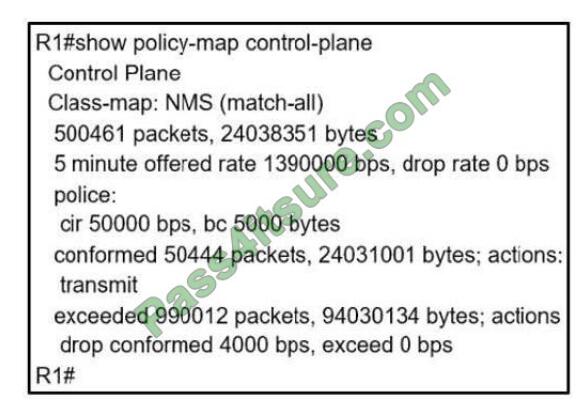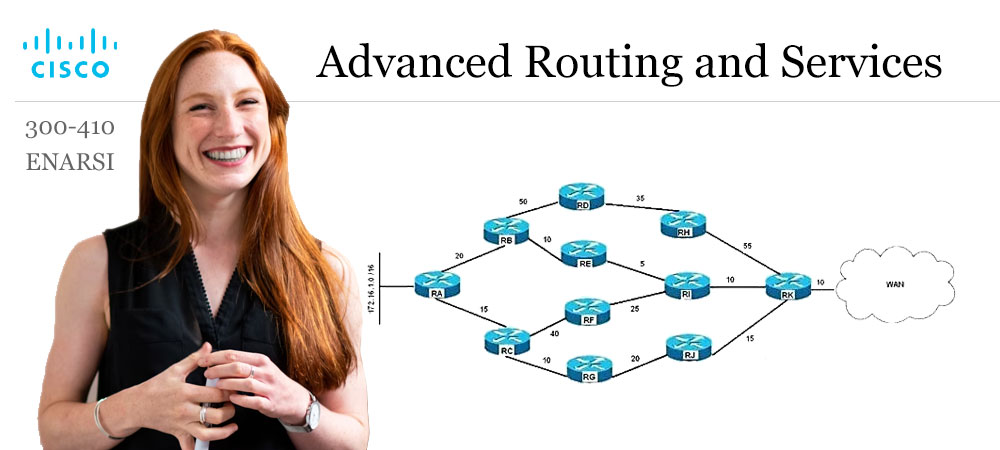
As of February 2025, we have updated the 300-410 exam dumps to ensure they are current. Remember, it is the latest and you are welcome to learn.
Prepare for the Cisco CCNP 300-410 exam: First: 300-410 exam dumps practice test, Second: Pass4itsure Cisco expert. You can get free Cisco 300-410 exam practice test questions, Cisco CCNP 300-410 dumps pdf here.
| Prep Exam | Pass4itsure Cisco expert |
| Q&As | 925 |
| Single & multiple choice | 891 |
| Drag & Drop | 24 |
| Simulation labs | 10 |
A Great Choice – Pass4itsure
Pass4itsure updated the Cisco 300-410 dumps questions! The latest Cisco 300-410 test questions can help you pass the exam! Preparing for exams with the help of Pass4itsure’s braindumps and study guides will prove a supportive & rewarding learning experience for you.
Update test questions throughout the year! The most complete test questions and answers! The safest buying experience! The biggest free sharing exam practice questions and answers!
Download The Cisco 300-410 Dumps Pdf From Google Drive:
Free 300-410 dumps pdf [2025] https://drive.google.com/file/d/1QymQE-TomTBSZAD8OD-IDUuZZWTUh-uA/view?usp=sharing
Latest Cisco 300-410 Practice test questions
| Number of exam questions | Formart | Updated | View ENARSI exam topics |
| 15 | Document | Feb 05, 2025 | 300-410 ENARSI v1.1 Exam Topics |
Question #1:
Refer to the exhibit.
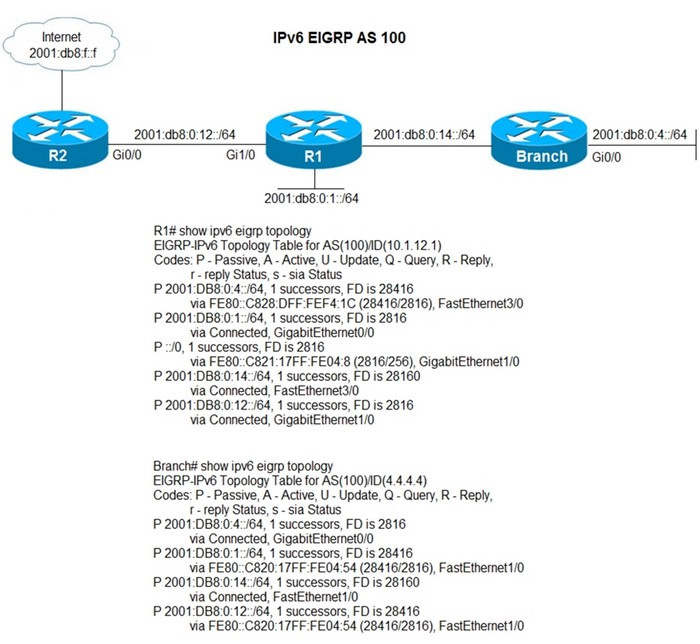
Users in the branch network of 2001:db8:0:4::/64 report that they cannot access the Internet. Which command is issued in IPv6 router EIGRP 100 configuration mode to solve this issue?
A. Issue the eigrp stub command on R1.
B. Issue the no eigrp stub command on R1.
C. Issue the eigrp stub command on R2.
D. Issue the no eigrp stub command on R2.
Correct Answer: B
By observing the routing table we can determine that:
1) the default static route isn\’t learned on the branch router
2) R1 networks were learned. This concludes that on R1 we have eigrp stub connected which advertises only connected networks to Branch router.
Question #2:
Refer to the exhibit
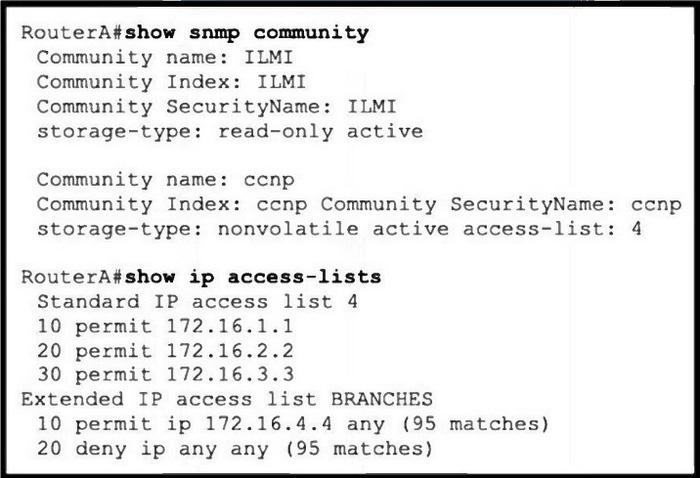
The SNMP server with IP address 172.16 4 4 cannot access host router A
Which configuration command on router A resolves the issue?
A. snmp-server community ccnp
B. access-list 4 permit 172.16.4.0 0.0.0.3
C. access-list 4 permit host 172.16.4.4
D. snmp-server host 172.16.4.4 ccnp
Correct Answer: C
Question #3:
Which of the following statements are true regarding the e IPv6 RA Guard feature?
A. This feature is support on LAG bundles interfaces
B. This feature is supported on private VLANs
C. Packets dropped by the IPv6 RA Guard feature cannot be spanned.
D. This feature offers protection in networks where IPv6 traffic is tunneled.
Correct Answer: B
Question #4:
An engineer configured two routers connected to two different service providers using BGP with default attributes. One of the links is presenting high delay, which causes slowness in the network. Which BGP attribute must the engineer configure to avoid using the high-delay ISP link if the second ISP link is up?
A. LOCAL_PREF
B. MED
C. WEIGHT
D. AS-PATH
Correct Answer: A
Question #5:
Refer to the exhibit.
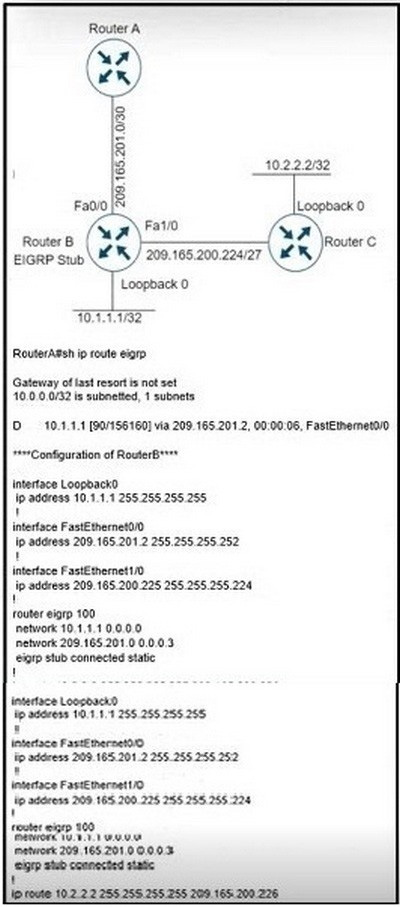
Not all connected and static routes of router B are received by router A even though EIGRP neighborship is established between the routers. Which configuration resolves the issue?
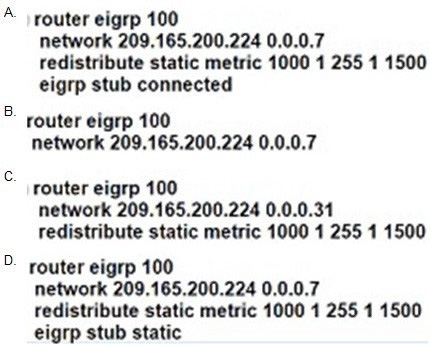
A. Option A
B. Option B
C. Option C
D. Option D
Correct Answer: D
Question #6:
Which command allows traffic to load-balance in an MPLS Layer 3 VPN configuration?
A. multi-paths eibgp 2
B. maximum-paths 2
C. maximum-paths ibgp 2
D. multi-paths 2
Correct Answer: C
Question #7:
In order to connect between disparate OSPF and EIGRP portions of a network, mutual route redistribution has been configured. What are two disadvantages of doing this? (Choose two.)
A. Prone to routing loops if not done correctly
B. Differing metrics between the routing protocols could result in sub-optimal routing.
C. Route redistribution is not supported on most Cisco router platforms.
D. Increased convergence times.
Correct Answer: AB
Question #8:
Refer to the exhibit. R5 should not receive any routes originated in the EIGRP domain.
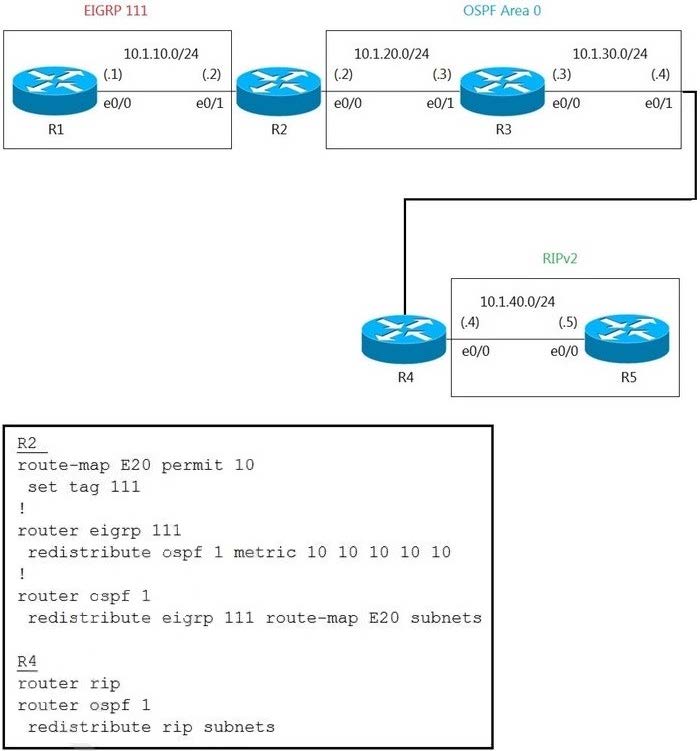
Which set of configuration changes removes the EIGRP routes from the R5 routing table to fix the issue?
A. R4 route-map O2R deny 10 match tag 111 route-map O2R permit 20 ! router rip redistribute ospf 1 route-map O2R metric 1
B. R2 route-map E20 deny 20 R4 route-map O2R deny 10 match tag 111 ! router rip redistribute ospf 1 route-map O2R metric 1
C. R4 route-map O2R permit 10 match tag 111 route-map O2R deny 20 ! router rip redistribute ospf 1 route-map O2R metric 1
D. R4 route-map O2R deny 10 match tag 111 ! router rip redistribute ospf 1 route-map O2R metric 1
Correct Answer: A
Question #9:
Refer to the exhibit.
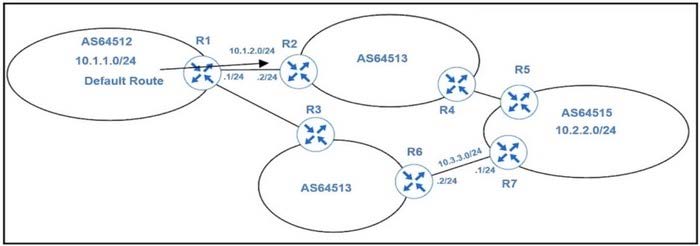
An engineer must configure PBR on R1 to reach to 10.2.2.0/24 via R3 AS64513 as the primary path and a backup route through default route via R2 AS64513. All BGP routes are in the routing table of R1. but a static default route overrides BGP routes.
Which PBR configuration achieves the objective?
A. access-list 100 permit ip 10.1.1.0 0.0.0.255 10.2.2.0 0.0.0.255 ! route-map PBR permit 10 match ip address 100 set ip next-hop recursive 10.3.3.1
B. access-list 100 permit ip 10.1.1.0 255.255.255.0 10.2.2.0 255.255.255.0 ! route-map PBR permit 10 match ip address 100 set ip next-hop recursive 10.3.3.1
C. access-list 100 permit ip 10.1.1.0 0.0.0.255 10.2.2.0 0.0.0.255 ! route-map PBR permit 10 match ip address 100 set ip next-hop 10.3.3.1
D. access-list 100 permit ip 10.1.1.0 255.255.255.0 10.2.2.0 255.255.255.0 ! route-map PBR permit 10 match ip address 100 set ip next-hop 10.3.3.1
Correct Answer: A
Question #10:
As the network administrator, you need to develop a verification plan for an OSPF network. The OSPF network has several area routers, area border routers (ABRs), and autonomous system boundary routers (ASBRs).
Which LSA types should you expect ABRs to generate while verifying the OSPF network? (Choose two.)
A. Type 4
B. Type 3
C. Type 2
D. Type 5
Correct Answer: AB
ABRs generate Type 3 and Type 4 LSAs in an OSPF network. ABRs are those routers that exist between two OSPF areas, as shown in the following figure:

Type 3 and Type 4 LSAs are generated by ABRs to be flooded into other areas to and from the backbone area (area 0). Type 3 LSAs, or summary link advertisements, contain the list of networks known by one area. ABRs send Type 3 LSAs
to the other OSPF areas in a given AS.
OSPF ABRs generates Type 4 LSAs to advertise the list of routes that point to an ASBR. These LSAs advertise the location of the ASBR.
Type 5 LSAs are not generated by an ABR. These LSAs are generated by ASBRs to describe routes redistributed into the area from other autonomous systems.
Type 2 LSAs are not generated by an ABR. A Type 2 LSA is generated only by the designated router (DR) of a segment to be sent to the other routers that belong to the same area as the DR. A DR is a router that has the highest OSPF
priority on a segment. These advertisements are used by the DR to represent the routers that are connected to the network.
Objective:
Layer 3 Technologies
Sub-Objective:
Configure and verify network types, area types, and router types
References:
Cisco Learning Home > Groups > CCNP RandS Study Group > Discussions > OSPF Level of Detail Cisco > Support > Technology Support > IP > IP Routing > Technology Information > Technology White Paper > OSPF Design Guide > Link
State Packets
Question #11:
Refer to the exhibit.
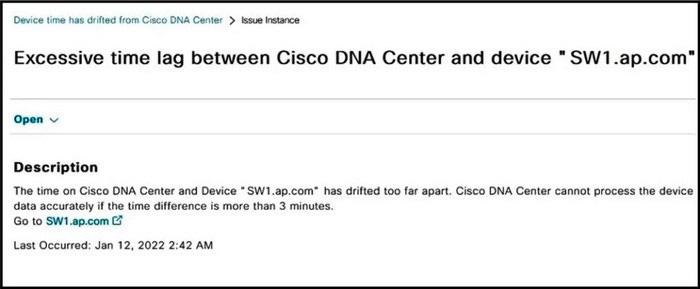
Which action resolves the issue?
A. Establish connectivity between the NTP server and the switch.
B. Configure the local time on the SW1 device.
C. Configure the local time on Cisco DNA Center.
D. Establish connectivity between the NTP server and Cisco DNA Center.
Correct Answer: A
Question #12:
Which two statements about VRF-Lite configurations are true? (Choose two.)
A. They support the exchange of MPLS labels
B. Different customers can have overlapping IP addresses on different VPNs
C. They support a maximum of 512.000 routes
D. Each customer has its own dedicated TCAM resources
E. Each customer has its own private routing table.
F. They support IS-IS
Correct Answer: BE
Question #13:
Refer to the exhibit.
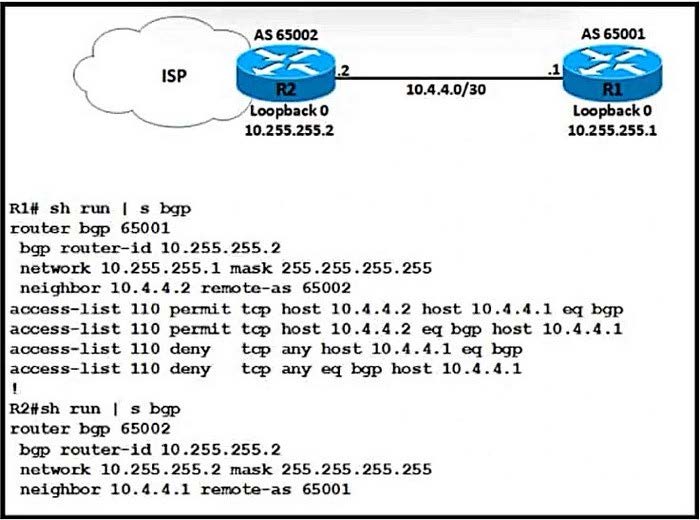
A network engineer notices that R1 and R2 cannot establish an eBGP peering. The following messages appear in the log:
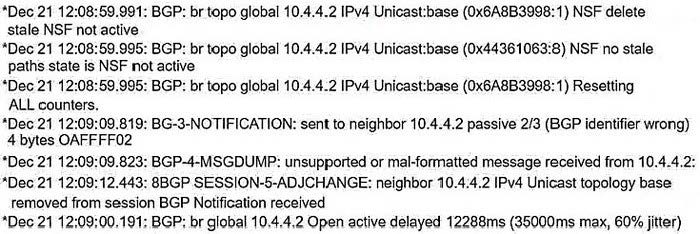
Which configuration must the engineer apply to R1 to restore the eBGP peering?
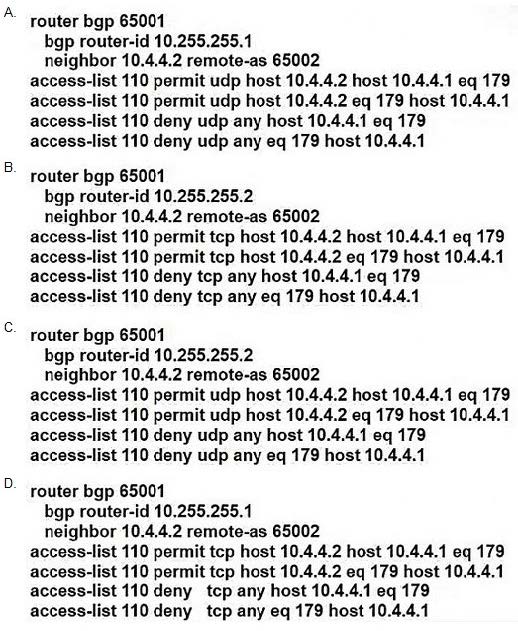
A. Option A
B. Option B
C. Option C
D. Option D
Correct Answer: D
Question #14:
Refer to the exhibit.
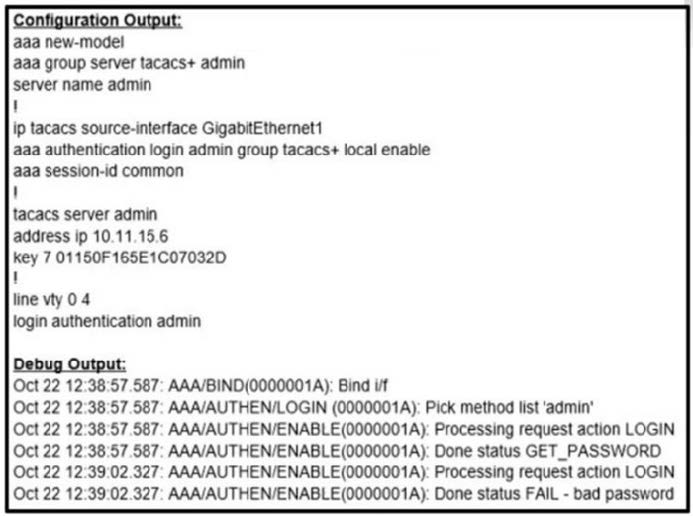
An administrator configured a Cisco router for TACACS authentication, but the router is using the local enable password instead. Which action resolves the issue?
A. Configure the aaa authentication login default group admin local if-authenticated command instead.
B. Configure the aaa authentication login admin group tacacs+ local enable none command instead.
C. Configure the aaa authentication login admin group tacacs+ local if-authenticated command instead.
D. Configure the aaa authentication login admin group admin local enable command instead.
Correct Answer: D
Question #15:
Refer to the exhibit.
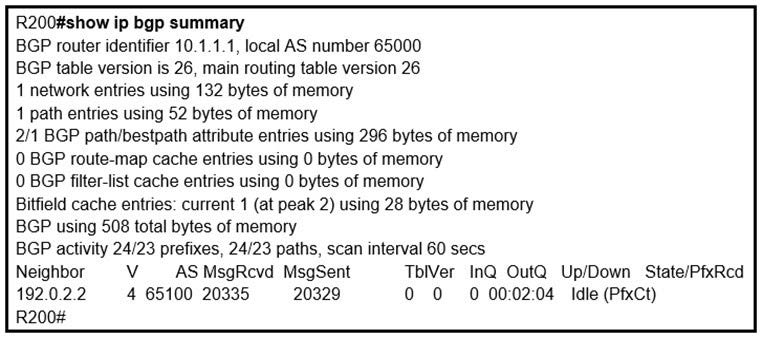
In which circumstance does the BGP neighbor remain in the idle condition?
A. if prefixes are not received from the BGP peer
B. if prefixes reach the maximum limit
C. if a prefix list is applied on the inbound direction
D. if prefixes exceed the maximum limit
Correct Answer: D
Try our amazing dumps
For the CCNP Enterprise certification, you first need to pass the 350-401 ENCOR core exam, and then choose any exam starting with 300-4.
This article mainly analyzes the latest 300-410 ENARSI exam questions. You can find other related exams in Ducktown.
There are many kinds of learning resources now, including online video tutorials, books, various trainings, etc. But this article recommends you the Pass4itsure dumps resource. Why do you recommend it?
- Save time
- High cost performance
- Safe, the current market is very mature, and it also includes a money-back guarantee
- The pass rate is high, which has been verified by practice.
5.365 days of free updates - Free assessment, using the latest assessment materials, to check your skills and abilities in 300-410 ENARSI.
This is why I recommend him. You can choose the best learning method according to your actual situation.
Conclusion:
Cisco 300-410 exam is a very popular certification exam. Practicing the latest exam questions can greatly improve your exam passing rate.
This article shares the Latest Cisco 300-410 Practice test questions and provides analysis of test answers to help you quickly improve and cope with the latest exam. If you don’t have time to read the complete article now, you can also download the 300-410 dumps pdf.
What’s more, Pass4itsure dumps contain complete access to the latest exam questions and answers, providing an exclusive edge in itself and truly serving as the best preparation for you as an individual or as a team.
